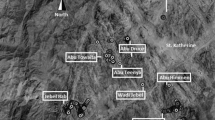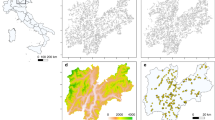Abstract
Orophilous species are often unable to escape the consequences of climate change because mountains are surrounded by unsuitable habitats. Among them, several endemic species belonging to the genus Erebia Dalman (Lepidoptera, Nymphalidae, Satyrinae) can be considered as key species to assess the risk of biodiversity loss of mountain habitats. The aim of this paper is to measure changes that have occurred in the altitudinal distribution of Erebia cassioides on the Pollino Massif (Southern Italy) during the last 37 years. Sixteen sites sampled in 1975 have been resampled after about three decades (2004, 2012). In 1975 56 % of the sampled population inhabited sites above and 44 % sites below the treeline, while in 2004 and 2012 99 % of the population were observed above the treeline. Furthermore, we observed an uphill shift of 180 m in the barycentre altitude of the species distribution and an unexpected increased density of the population above the treeline which led to a range reduction coupled to population increase of E. cassioides. This pattern contrasts with the usually observed one that couples habitat reduction to population decreasing. The reason for the observed pattern is unclear, but the implication for conservation strategies could be important if confirmed for other species. In fact, during coming decades local extinctions as a consequence of climate change might be fewer and more delayed than expected, and relict populations of cold adapted species could be preserved for a longer time span within optimal habitat refugia.



Similar content being viewed by others
References
Albre J, Gers C, Legal L (2008) Molecular phylogeny of the Erebia tyndarus (Lepidoptera, Rhopalocera, Nymphalidae, Satyrinae) species group combining CoxII and ND5 mitochondrial genes: a case study of a recent radiation. Mol Phylogenet Evol 47:196–210
Balletto E, Toso G, Barberis G, Barberis G, Rossaro B (1977) Aspetti dell’ecologia dei Lepidotteri Ropaloceri nei consorzi erbacei alto Appenninici. Animalia 4:277–343
Blondel J (1979) Biogèographie et ècologie. Masson, Paris
Brandmayr P, Mingozzi T, Scalercio S, Passalacqua D, Rotondaro F, Pizzolotto R (2002) Stipa austroitalica garigues and mountain pastureland in the Pollino National Park (Calabria, Southern Italy). In: Redecker B, Finck P, Härdtle W, Riecken U, Schröder E (eds) Pasture Landscapes and Nature Conservation. Springer, Berlin, Heidelberg, pp 53–66
Brandmayr P, Pizzolotto R, Scalercio S (2003) Overview: invertebrate diversity in Europe’s alpine regions. In: Nagy L, Grabherr G, Körner C, Thompson DBA (eds) Alpine biodiversity in Europe. Springer, Berlin, Heidelberg, pp 233–237
Brunetti M, Maugeri M, Fabio M, Nanni T (2006) Temperature and precipitation variability in Italy in the last two centuries from homogenised instrumental time series. Int J Climatol 26:345–381
Brunetti M, Caloiero T, Coscarelli R, Gullà G, Nanni T, Simolo C (2012) Precipitation variability and change in the Calabria region (Italy) from a high resolution daily dataset. Int J Climatol 32:57–73
Chen I-C, Hill JK, Shiu H-J, Holloway JD, Benedick S, Chey VK, Barlow HS, Thomas CD (2011) Asymmetric boundary shifts of tropical montane Lepidoptera over four decades of climate warming. Glob Ecol Biogeogr 20:34–45
Cizek O, Bakesová A, Kuras T, Benes J, Konvicka M (2003) Vacant niche in alpine habitat: the case of an introduced population of the butterfly Erebia epiphron in the Krkonoše Mountains. Acta Oecol 24:15–24
De Groot M, Rebeušek F, Grobelnik V, Govedič M, Šalamun A, Verovnik R (2009) Distribution modeling as an approach to the conservation of a threatened alpine endemic butterfly (Lepidoptera: Satyridae). Eur J Entomol 106:77–84
Franco AMA, Hill JK, Kitschke C, Collingham YC, Roy DB, Fox R, Huntley B, Thomas CD (2006) Impacts of climate warming and habitat loss on extinctions at species’ low-latitude range boundaries. Glob Chang Biol 12:1545–1553
Haslett JR (1997) Mountain ecology: organism responses to environmental change, an introduction. Glob Ecol Biogeogr Lett 6:3–6
Hickling R, Roy DB, Hill JK, Fox R, Thomas CD (2006) The distributions of a wide range of taxonomic groups are expanding polewards. Glob Chang Biol 12:450–455
Higgins LG, Riley ND (1983) Farfalle d’Italia e d’Europa. Rizzoli Editore, Milano
Kleckova I, Konvicka M, Klecka J (2014) Thermoregulation and microhabitat use in mountain butterflies of the genus Erebia: importance of fine-scale habitat heterogeneity. J Therm Biol 41:50–58
Konvicka M, Maradová M, Beneš J, Fric Z, Kepka P (2003) Uphill shifts in distribution of butterflies in the Czech Republic: effects of changing climate detected on a regional scale. Glob Ecol Biogeogr 12:403–410
Lattes A, Mensi P, Cassulo L, Balletto E (1994) Genotypic variability in western European members of the Erebia tyndarus species group (Lepidoptera, Satyridae). Nota Lepidopterol 5:93–104
Olff H, Ritchie ME (1998) Effects of herbivores on grassland plant diversity. Trends Ecol Evol 13:261–265
Parenzan P, Scalercio S (2001) Presenza di Setina irrorella (Linnaeus, 1758) in Italia meridionale e di Setina roscida (Denis & Schiffermüller, 1775) in Abruzzo; considerazioni sulle specie europee del genere Setina Schrank (Lepidoptera: Arctiidae, Lithosiinae). Entomologica 35:89–101
Parmesan C, Yohe G (2003) A globally coherent fingerprint of climate change impacts across natural systems. Nature 421:37–41
Pizzolotto R, Sapia M, Rotondaro F, Scalercio S, Brandmayr P (2010) A georeferenced biodiversity databank for evaluating the impact of climate change in southern Italy mountains. In: Körner C, Spehn EM (eds) Data mining for global trends in mountain biodiversity. CRC Press, Taylor & Francis, Boca Raton, pp 137–147
Pollard E, Yates TJ (1993) Monitoring butterflies for ecology and conservation. Chapman & Hall, London
Scalercio S (2009) On top of a mediterranean massif: climate change and conservation of orophilous moths at the southern boundary of their range (Lepidoptera: Macroheterocera). Eur J Entomol 106:231–239
Schmitt T, Hewitt G (2004) The genetic pattern of population threat and loss: a case study of butterflies. Mol Ecol 13:21–31
Schmitt T, Cizek O, Konvicka M (2005) Genetics of a butterfly relocation: large, small and introduced populations of the mountain endemic Erebia epiphrion silesiana. Biol Conserv 123:11–18
Settele J, Kudrna O, Harpke A, Kühn I, Van Swaay C, Verovnik R, Warren M, Wiemers M, Hanspach J, Hickler T, Kühn E, Halder I, Veling K, Vliegenthart A, Wynhoff I, Schweiger O (2008) Climatic risk atlas of European butterflies. Biorisk 1 (Special Issue). Pensoft Publishers, Sofia
Shoo LP, Williams SE, Hero J-M (2005) Potential decoupling of trends in distribution area and population size of species with climate change. Glob Chang Biol 11:1469–1476
Tolman T, Lewington R (1999) Guide des papillons d’Europe et d’Afrique du Nord. HarperCollins, Lausanne
van Swaay C, Wynhoff I, Verovnik R, Wiemers M, López Munguira M, Maes D, Sasic M, Verstrael T, Warren M, Settele J (2010) Erebia cassioides. In: IUCN 2012. IUCN Red List of Threatened Species. Version 2012.2. www.iucnredlist.org. Accessed 19 March 2013
Vrba P, Konvicka M, Nedved O (2012) Reverse altitudinal cline in cold hardiness among Erebia butterflies. CryoLetters 33(4):251–258
Wilson RJ, Gutiérrez D, Gutiérrez J, Martinez D, Agudo R, Monserrat VJ (2005) Changes to the elevational limits and extent of species ranges associated with climate change. Ecol Lett 8:1138–1146
Zografou K, Kati V, Grill A, Wilson RJ, Tzirkalli E, Pamperis LN, Halley JM (2014) Signals of climate change in butterfly communities in a mediterranean protected area. PLoS ONE 9(1):e87245. doi:10.1371/journal.pone.0087245
Acknowledgments
Research supported by the Ministry of University and Education of Italy (PRIN D.M. 19 marzo 2010, n. 51, prot. 200947YRB9 Impact of global change on ecosystems, animal communities and species of alpine and mediterranean areas of italy: models, scenarios and evaluation from macro-to microscale, based on ecology and philogeography of vertebrates and invertebrates).
Author information
Authors and Affiliations
Corresponding author
Rights and permissions
About this article
Cite this article
Scalercio, S., Bonacci, T., Mazzei, A. et al. Better up, worse down: bidirectional consequences of three decades of climate change on a relict population of Erebia cassioides . J Insect Conserv 18, 643–650 (2014). https://doi.org/10.1007/s10841-014-9669-x
Received:
Accepted:
Published:
Issue Date:
DOI: https://doi.org/10.1007/s10841-014-9669-x




